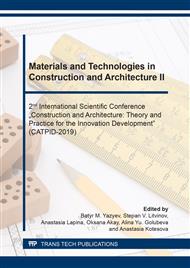[1]
V.V. Novozhilov, Theory of thin shells, Publishing house of S.-Petersburg University, Saint-Petersburg, (2010).
Google Scholar
[2]
S.P. Timoshenko, S. Voinovsky-Krieger, Plate and shell, Science, Moscow, (1966).
Google Scholar
[3]
R.A. Kayumov, I.Z. Mukhamedova, G.F. Khaziyeva, Loss of stability of sheet oblique consoles, News of the Kazan State University of Architecture and Civil Engineering. 3 (45) (2018) 129-135.
Google Scholar
[4]
Kim A.Yu., S.V. Polnikov, Strengthening of soft shells of pneumatic structures with steel ropes and arches, In the collection: prospects for the development of science and education, collection of scientific papers based on the materials of the IV International Scientific and Practical Conference. Edited by A.V. Tugolukov (2016) 107-109.
Google Scholar
[5]
P.A. Akimov, A.M. Belostosky, T.B. Kaytukov, M.L. Mozgaleva, M. Aslami, About several numerical and semianalytical methods of local structural analysis, International Journal for Computational Civil and Structural Engineering. 14 (4) (2018) 59-69.
DOI: 10.22337/2587-9618-2018-14-4-59-69
Google Scholar
[6]
F. Aldakheel, B. Hudobivnik, and P. Wriggers, Virtual element formulation for phase-field modeling of ductile fracture," Submitted to International Journal for Multiscale Computational Engineering, (2018).
DOI: 10.1615/intjmultcompeng.2018026804
Google Scholar
[7]
A.S. Chepurnenko, B.M. Yazyev, M.S. Turko, Calculation of cylindrical corrugated structures using semi-analytical finite element method, Construction and technological safety. 12 (64) (2018) 49-56.
DOI: 10.4028/www.scientific.net/msf.931.3
Google Scholar
[8]
A.V. Ignatiev, V.A. Ignatiev, E.A. Gamzatova, Calculation of thin plates by the method of finite elements in the form of the classical mixed method with the exception of the movement of finite elements as a rigid whole, News of higher educational institutions. Building. 3 (711) (2018) 5-13.
Google Scholar
[9]
P. Wriggers, B. Hudobivnik, J. Schrode, Finite and virtual element formulations for large strain anisotropic material with inextensive bers, in Multiscale Modeling of Heterogeneous Structures (J. Soric and P. Wriggers, eds.), (Cham), Springer International, (2017).
DOI: 10.1007/978-3-319-65463-8_11
Google Scholar
[10]
Nguyen Nhung, Waas Anthonym, Nonlinear, finite deformation,finite element analysis, ZAMP. Z. Angew. math.and Phys. 9 (67) (2016) 351-352.
DOI: 10.1007/s00033-016-0623-5
Google Scholar
[11]
S.L. Paznanova, G.P. Vasilev, P.S. Dineva, G.D. Manolis, Dynamic analysis of nanoheterogeneities in a finite-sized solidby boundary and finite element methods, Int. J. Solids and Struct. 80 (2016) 1-18.
DOI: 10.1016/j.ijsolstr.2015.10.016
Google Scholar
[12]
L.I. Sedov, Continuum mechanics. T.1, Science, Moscow, (1976).
Google Scholar


